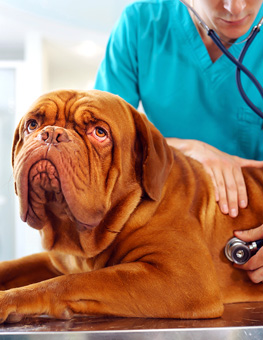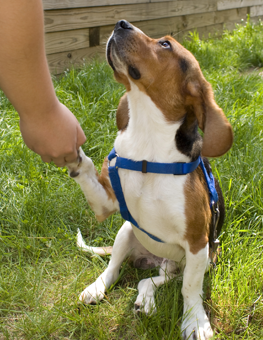How to Manage the Symptoms of your Dog’s Urinary Incontinence
Providing a clean and healthy home environment is an important part of the management and treatment of your dog’s urinary incontinence.

When a dog has persistent accidents, it may be due to a medical problem.
Written by Victoria Lewis, Veterinarian and Pharmacist
What is urinary incontinence?
Urinary incontinence is when your dog has persistent accidents that are not intentional, and not behavior-based. You may notice urine leaking or dribbling from your dog when they are walking or after they have finished urinating, or find pools of urine or wet spots on the floor or furniture where your dog has been lying to rest or sleep. You may also notice wet fur and red, irritated skin (called urine scald) along with the distinctive smell of urine on the back legs and hind end. Often, dogs are completely unaware they are leaking urine.
Urinary incontinence is commonly seen in medium to large breed female dogs that have been spayed, although the condition can occur in any dog.
What can I do to help my dog at home?
In addition to seeking medical treatment from your veterinarian, there are many steps you can take to manage your dog’s symptoms, and accidents at home. By making a few lifestyle and environmental changes, you will be helping to keep your dog healthy, happy and supported. These steps include the following:
- Most importantly, never scold or punish your dog for having an accident. They cannot control the leaking and are not urinating intentionally.
- Try to increase the amount of time your dog spends outdoors by allowing them free access to a backyard or dog park, or by increasing the number of times they are walked during the day. Before going to bed, take your dog outside one last time so he can empty his bladder.
- Purchase dog beds, blankets, and furniture covers that can easily and regularly be washed, or replaced. Maintain clean bedding and change daily, or as needed.
- Use leak proof pads under bedding and on furniture to protect surfaces and make clean up easier.
- Use disposable diapers and male wraps to absorb and contain any urine leakage.
- Gently wash the areas of skin that routinely become urine soaked by using a mild dog shampoo, and towel dry. By keeping these areas clean and dry you will help prevent urine scald and breakdown of the skin barrier which can lead to infection
What are the causes of urinary incontinence?
There are many medical reasons why your dog may be showing signs of urinary incontinence. Some of the main reasons include the following:
- Urethral Incompetence. Urethral incompetence is when the muscles and tissues of the urethra (the tube that allows exit of urine from the bladder) weaken and fail to function properly. This is the most common reason for urinary incontinence and is usually seen in dogs that have been spayed or neutered.
- Anatomical Abnormalities. This category includes birth defects of the urinary tract or surrounding tissues. One example includes ectopic ureters. Ureters are the tubes that normally carry urine from the kidneys to the bladder. When they are “ectopic”, it means they do not attach to the bladder, but instead to another location such as the urethra, which leads to dribbling and urine leakage. Physical injury or damage that alters the normal anatomy of the urinary tract is also included in this category.
- Neurological Causes. The ability to urinate is a complex interaction between the nervous system and the muscles that control elimination. Dogs with brain or spinal cord injury or neurological diseases that affect the normal functioning of the bladder and urinary tract may exhibit signs of urinary incontinence.
-

Your vet will be able to prescribe the most appropriate treatment for your dog's incontinence.
Obstruction. Bladder stones and sludge within the bladder and urethra may cause partial obstruction within the urinary tract allowing urine to pass intermittently and with difficulty. You may notice your dog straining, or re-positioning to urinate, with spurts of urine eliminated forcefully, or urine may leak out passively when they are at rest.
- Cognitive Dysfunction and Aging. Dogs can develop dementia (or cognitive dysfunction) as they age and may not always be aware they are urinating inappropriately. Incontinence in this age group can also be associated with weakening of the bladder muscles, or severe arthritis that doesn’t allow the dog to get into the proper position to fully empty the bladder.
- Other Causes. Urinary tract infections, metabolic diseases such as diabetes, kidney disease, or tumors that interfere with the normal functioning of the urinary tract.
Can urinary incontinence be treated?
Yes, in most cases urinary incontinence can be effectively treated. For instance, to treat urethral incompetence, your veterinarian may prescribe hormonal-based medications such as estrogen compounds for females, testosterone for males, or phenylpropanolamine to strengthen the muscles and tissues in the urinary tract that help retain urine in the bladder. Other treatments such as antibiotics for infection, anti-inflammatory and pain medications for arthritis, and medications for diabetes and other metabolic diseases may be prescribed. Surgery may be required in cases of spinal cord injury, bladder stones, and anatomical defects of the urinary tract.
It is very important that you have your dog seen by a veterinarian if you notice any signs of urinary incontinence. Your veterinarian will perform specific diagnostic tests to narrow down the wide range of causes, and prescribe the most appropriate treatment for your dog. The type of treatment your dog receives will depend on what is causing the incontinence.



















